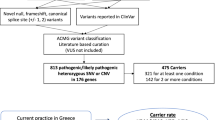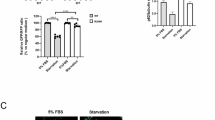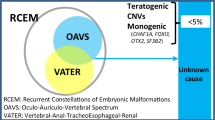Abstract
Auriculo-condylar syndrome (ACS), an autosomal dominant disorder of first and second pharyngeal arches, is characterized by malformed ears (‘question mark ears’), prominent cheeks, microstomia, abnormal temporomandibular joint, and mandibular condyle hypoplasia. Penetrance seems to be complete, but there is high inter- and intra-familial phenotypic variation, with no evidence of genetic heterogeneity. We herein describe a new multigeneration family with 11 affected individuals (F1), in whom we confirm intra-familial clinical variability. Facial asymmetry, a clinical feature not highlighted in other ACS reports, was highly prevalent among the patients reported here. The gene responsible for ACS is still unknown and its identification will certainly contribute to the understanding of human craniofacial development. No chromosomal rearrangements have been associated with ACS, thus mapping and positional cloning is the best approach to identify this disease gene. To map the ACS gene, we conducted linkage analysis in two large ACS families, F1 and F2 (F2; reported elsewhere). Through segregation analysis, we first excluded three known loci associated with disorders of first and second pharyngeal arches (Treacher Collins syndrome, oculo-auriculo-vertebral spectrum, and Townes–Brocks syndrome). Next, we performed a wide genome search and we observed evidence of linkage to 1p21.1–q23.3 in F2 (LOD max 3.01 at θ=0). Interestingly, this locus was not linked to the phenotype segregating in F1. Therefore, our results led to the mapping of a first locus of ACS (ACS1) and also showed evidence for genetic heterogeneity, suggesting that there are at least two loci responsible for this phenotype.
Similar content being viewed by others
Log in or create a free account to read this content
Gain free access to this article, as well as selected content from this journal and more on nature.com
or
References
Jampol M, Repetto G, Keith DA, Curtin H, Remensynder J, Holmes LB : Prominent constricted ears with malformed condyle of the mandible. Am J Med Genet 1998; 75: 449–452.
Guion-Almeida ML, Zechi-Ceide RM, Vendramini S, Kokitsu-Nakata NM : Auriculo-condilar syndrome: additional patients. Am J Med Genet 2002; 112: 209–214.
Erlich MS, Cunningham ML, Hudgins L : Transmission of the dysgnathia complex from mother to daughter. Am J Med Genet 2000; 95: 269–274.
Storm AL, Johnson JM, Lammer E, Green GE, Cunniff C : Auriculo-condylar syndrome is associated with highly variable ear and mandibular defects in multiple kindreds. Am J Med Genet 2005; 138: 141–145.
Priolo M, Lerone M, Rosaia L et al: Question mark ears temporo-mandibular joint malformation and hypotonia: auriculo-condylar syndrome or a distinct entity? Clin Dysmorph 2000; 9: 277–280.
Kelberman D, Tyson J, Chandler DC et al: Hemifacial microsomia: progress in understanding the genetic basis of a complex malformation syndrome. Hum Genet 2001; 109: 638–645.
Miller SA, Dykes DD, Polesky HF : A simple testing out procedure for extracting DNA from human nucleated cells. Nucleic Acids Res 1998; 16: 1215.
Richards B, Skoletsky J, Shuber AP et al: Multiplex PCR amplification from the CFTR gene using DNA prepared from buccal brushes/swabs. Hum Mol Genet 1993; 2: 159–163.
Abecasis GR, Cherny SS, Cookson WO, Cardon LR : Merlin-rapid analysis of dense genetic maps using sparse gene flow trees. Nat Genet 2002; 30: 97–101.
Guion-Almeida ML, Kokitsu-Nakata NM, Zechi-Ceide RM, Vendramini S : Auriculo-condilar syndrome: further evidence for a new disorder. Am J Med Genet 1999; 86: 130–133.
Uuspää V : Combined bilateral external ear deformity and hypoplastic mandible. Scand J Plast Reconstr Surg 1978; 12: 165–167.
Poswillo D : The pathogenesis of the first and second branchial arch syndromes. Oral Surg Oral Med Oral Pathol 1973; 35: 302–328.
Vendramini S, Richieri-Costa A, Guion-Almeida ML : Oculoauriculovertebral spectrum with radial defects: a new syndrome or an extension of the oculoauriculovertebral spectrum? Report of fourteen Brazilian cases and review of the literature. Eur J Hum Genet 2007; 15: 411–421.
The Treacher Collins Collaborative Group: Positional cloning of a gene involved in the pathogenesis of Treacher Collins syndrome. Nat Genet 1996; 12: 130–136.
Splendore A, Fanganiello RD, Masotti C, Morganti LSC, Passos-Bueno MR : TCOF1 mutation database: novel mutation in the alternatively spliced Exon 6A and update in mutation nomenclature. Hum Mutat 2005; 25: 429–434.
Fisher S, Ludecke HJ, Wieczorek D, Bohringer S, Gillessen-Kaesbach G, Horsthemke B : Histone acetylation dependent allelic expression imbalance of BAPX1 in patients with the oculo-auriculo-vertebral spectrum. Hum Mol Genet 2006; 15: 581–587.
Agulnik SI, Papaioannou VE, Silver LM : Cloning, mapping, and expression analysis of TBX15, a new member of the T-box gene family. Genomics 1998; 51: 68–75.
Gong SG, Gong TW, Shum L : Identification of markers of the midface. J Dent Res 2005; 84: 69–72.
Mitsiadis TA, Romeas A, Lendahl U, Sharpe PT, Farges JC : Notch2 protein distribution in human teeth under normal and pathological conditions. Exp Cell Res 2003; 282: 101–109.
Larsson C, Lardelli M, White I, Lendahl U : The human NOTCH1, 2, and 3 genes are located at chromosome positions 9q34, 1p13–p11, and 19p13.2–p13.1 in regions of neoplasia-associated translocation. Genomics 1994; 24: 253–258.
Acknowledgements
We gratefully acknowledge the patients and their relatives. We would also like to thank Constância Gotto for secretarial assistance, Karina Lezirovitz and Fernanda Jehee for technical support. This work was supported by grants from Fundação de Amparo à Pesquisa do Estado de São Paulo (FAPESP/CEPID) and Conselho Nacional de Pesquisa (CNPq).
Author information
Authors and Affiliations
Corresponding author
Additional information
Supplementary Information accompanies the paper on European Journal of Human Genetics website (http://www.nature.com/ejhg)
Rights and permissions
About this article
Cite this article
Masotti, C., Oliveira, K., Poerner, F. et al. Auriculo-condylar syndrome: mapping of a first locus and evidence for genetic heterogeneity. Eur J Hum Genet 16, 145–152 (2008). https://doi.org/10.1038/sj.ejhg.5201955
Received:
Revised:
Accepted:
Published:
Issue date:
DOI: https://doi.org/10.1038/sj.ejhg.5201955
Keywords
This article is cited by
-
Prenatal diagnosis of auriculocondylar syndrome with a novel missense variant of GNAI3: a case report
BMC Pregnancy and Childbirth (2021)
-
Novel variants in GNAI3 associated with auriculocondylar syndrome strengthen a common dominant negative effect
European Journal of Human Genetics (2015)



